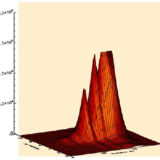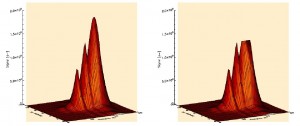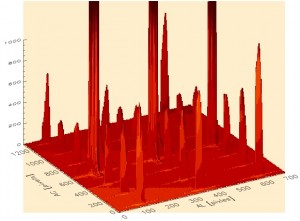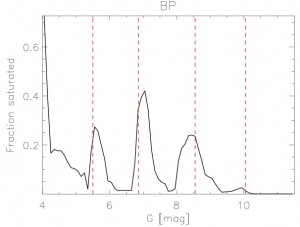Opening (activating) the gates of Gaia (14 Jul 2014)
Media: Gaia ESA blog and news
Title: “Opening (activating) the gates of Gaia”
Publication date: 14 July 2014
OPENING (ACTIVATING) THE GATES OF GAIA
The huge Gaia focal plane consists of 106 CCDs.
As you may know already from previous blog entries Gaia will fly the biggest camera ever into space. The image created by the two telescopes will be huge: about 1 m wide and 0.5 m high. To cover this entire area you need 106 different CCDs (detectors). Most of them are white light CCDs. Additionally there are blue sensitive (BP) and red sensitive (RP) CCDs. About one billion pixels (picture elements) are distributed over the focal plane as each CCD consists of about 9 million pixels.
Spectra of a red star observed by one red photometer (RP) without (left) and with saturation effect (right).
CCD images can have saturated pixels as you may have experienced with your digital camera when taking photos or videos and a bright light source is included in the image. This means that the pixels have reached the maximum level that can be recorded technically. This is the same for Gaia CCDs: if a bright star is observed then the central pixels of the image will be saturated. Obviously, this is not a positive thing if you want to measure the position and brightness of the star with very ultra-high precision as we want to do with Gaia. Therefore Gaia CCDs have a special operation mode with reduced exposure times for bright stars. We call this mode “observations with gates activated”.
Different low resolution spectra as observed by red (RP) CCDs for sources with the same magnitude detected on-board by the white light star mapper CCDs.
There are different “gates” with different effective exposure times available ranging from 0.01 seconds to 4.3 seconds to cover a huge magnitude (brightness) range that can be observed. These “gates” will be activated depending on the magnitude of the stars determined on-board the satellite by the star mapper (SM) CCDs which will “see” the stars first. A few seconds after these observations with the SM CCDs the same detected source will be observed by 11 more CCDs in the same row of the SM CCD that has detected this source. If the star is detected as bright then the “gates” will be activated to avoid the saturation of the images. Saturation depends on many factors such as the colour of the star, the scan motion of the satellite, and even how the image centre is located in intra-pixel space.
Simulation result for a tested “gate” configuration of one BP CCD: fraction of saturated observations per white light (G) magnitude.
Therefore you need a lot of simulations to determine what fraction of the images will saturate. You need to know at which pixel level the CCDs are saturating. These saturation levels are different from CCD to CCD, there are even variations of the saturation levels within one CCD chip. Therefore we will adopt the ranges of the magnitudes for the activation of the “gates” for 16 different areas of each CCD in an optimization process. It is my current task to determine the optimal parameters based on a huge number of realistic simulations.
These parameters need be uplinked to Gaia after launch and before the first DPAC-led observations start in late 2013 or early 2014. When the first real Gaia observations are downlinked we will have to check how close to reality our simulations were and that only a very limited fraction of images are saturated as aimed for.
This entry was submitted by Holger Voss, member of the Gaia UB team, member of the CU5 (photometric processing) of the Gaia Data Processing and Analysis Consortium (DPAC), working at the Universitat de Barcelona.










